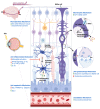Neuroprotective Effects and Therapeutic Potential of Transcorneal Electrical Stimulation for Depression
- PMID: 34572141
- PMCID: PMC8466154
- DOI: 10.3390/cells10092492
Neuroprotective Effects and Therapeutic Potential of Transcorneal Electrical Stimulation for Depression
Abstract
Transcorneal electrical stimulation (TES) has emerged as a non-invasive neuromodulation approach that exerts neuroprotection via diverse mechanisms, including neurotrophic, neuroplastic, anti-inflammatory, anti-apoptotic, anti-glutamatergic, and vasodilation mechanisms. Although current studies of TES have mainly focused on its applications in ophthalmology, several lines of evidence point towards its putative use in treating depression. Apart from stimulating visual-related structures and promoting visual restoration, TES has also been shown to activate brain regions that are involved in mood alterations and can induce antidepressant-like behaviour in animals. The beneficial effects of TES in depression were further supported by its shared mechanisms with FDA-approved antidepressant treatments, including its neuroprotective properties against apoptosis and inflammation, and its ability to enhance the neurotrophic expression. This article critically reviews the current findings on the neuroprotective effects of TES and provides evidence to support our hypothesis that TES possesses antidepressant effects.
Keywords: TES; antidepressant; depression; neuromodulation; neuroprotection; transcorneal electrical stimulation.
Conflict of interest statement
The authors declare no conflict of interest.
Figures


References
-
- WHO . WHO Depression Fact Sheet. World Health Organization (WHO); Geneva, Switzerland: 2020.
-
- WHO . Depression and Other Common Mental Disorders: Global Health Estimates. World Health Organization (WHO); Geneva, Switzerland: 2017.
-
- Association A.P. Diagnostic and Statistical Manual of Mental Disorders (DSM-5®) American Psychiatric Pub; Arlington, VA, USA: 2013.
Publication types
MeSH terms
Substances
Grants and funding
LinkOut - more resources
Full Text Sources
Medical

